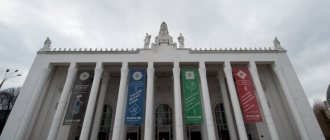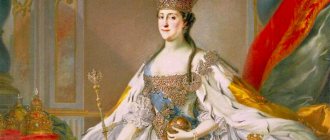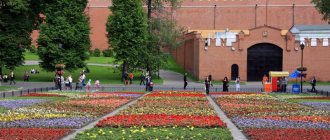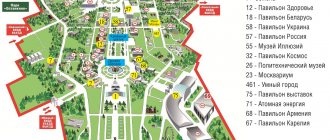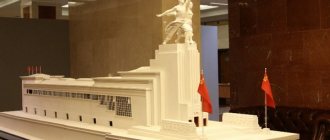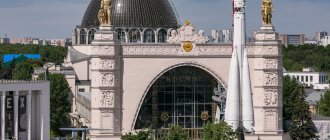Add to Favorites An exhibition by fashion historian Alexander Vasiliev, “VDNKh in Fashion. 1939-2019”, dedicated to the 80th anniversary of the exhibition complex, which was an iconic meeting and walking place for Soviet citizens and one of the main tourist attractions. Through the models of women's and men's clothing presented in the exhibition, you can trace how the lifestyle and thinking of our compatriots changed from the Stalin era through the Khrushchev thaw and Brezhnev stagnation to the present day.
This exhibition was created by the curator of the Alexander Vasiliev Foundation, designer Kirill Gasilin, who spent a lot of time selecting the exhibits. The exhibition is divided into zones in accordance with the decades to which the presented items of clothing and accessories belong. During the press tour, Alexander Vasiliev spoke in detail about each fashion decade. Here are the most entertaining excerpts from his excursion.
1930s
“Fashion in the 30s was formed under the influence of the militarization of society. Gradually, padded shoulders became a symbol of women's and men's fashion. They were invented in the early 30s by the famous designer Elsa Schiaparelli, who was inspired by the images of the leading actress of that decade, Greta Garbo, who was a swimmer in her youth and had broad shoulders.”
Greta Garbo
“The era of the 30s was associated with a feminine fit-and-flare silhouette. Soviet fashion has always been characterized by a shortage of fabrics. I repeat the well-known saying many times: “When I enter a Soviet store, I lose all my adrenaline.” It has always been very difficult with fabrics for sewing clothes. People had a hard time finding new fabrics to create costumes and most often had them altered. There were many needlewomen. Every Soviet woman knew how to knit, sew, and embroider. However, home sewing in a professional sense was persecuted. The so-called secret dressmakers were afraid of being arrested for their work.”
“Very little clothing from this period has survived, since Soviet people lived in cramped conditions and there was nowhere to store things, old clothes were either sent to the village or thrown into the trash. Therefore, if we find an authentic dress from the 30s and not yet black, this is real happiness. The main accessories of this era were a hat and gloves. Women did not go outside without them. A feature of the cut of the 30s was the bias cut. Interesting detail. In the 30s, buttons were made from two-kopeck and three-kopeck coins, which were covered with fabric.”
“Many models of this time were associated with Chinese imports. In the 30s, a lot of former Soviet citizens returned from Manchuria, from Harbin to the USSR, and brought with them a lot of clothes. For example, a jacket made of Chinese silk was made for Russian employees at the East China Railway.”
“In the fashion of the 30s, there was an active citation of folk costume. You see that these models resemble towels, embroidered shirts, and Russian folk shirts. The interest in these fabrics lies in the fact that they are unbleached flax sheets, which were usually used to make peasant clothing. The red scarf is the biggest squeak of Soviet fashion for that woman who is engaged in agriculture and came to VDNKh.”
Exhibition “Spring and Fashion. Collection from the Alexander Vasiliev Foundation"
Add to Favorites The exhibition “Spring and Fashion. Collection from the Alexander Vasiliev Foundation,” which also marked the opening of the Alexander Vasiliev Fashion Museum. This is the first of three exhibitions that viewers will see in 2021. We are also waiting for such exhibition projects as “Beach Fashion” and “Glamour of the 80s”.
The title of the exhibition “Spring and Fashion” speaks for itself. To the accompaniment of popular Soviet songs dedicated to the most romantic time of the year, visitors will be able to view more than 200 thematic items from the collection of Alexander Vasiliev: dresses, accessories, photographs, postcards. The exhibition presents both items of famous foreign couturiers (created by Dior, Lanvin, Courrèges, etc.) and creations of domestic designers, including a dress designed by Kirill Gasilin, the curator of the exhibition.
Alexander Vasiliev himself speaks about the relationship between spring and fashion: “Spring has a very strong influence on fashion. Firstly, after hibernation, this is the first warm season when women and men begin to undress. Spring is a great time when you don’t have to wear stockings and tights, gloves and mittens, fur coats and hats. Spring is an opportunity to move towards happier floral motifs in clothing.”
Cinemamode was lucky enough to attend the opening of the exhibition and take part in a fascinating excursion, which was personally conducted by Alexander Vasiliev. We present to your attention our photo report with excerpts from the story of the famous fashion historian.
A.V.: “Spring, a light breeze and sunshine force a woman to take off her heavy winter clothes, scarves, boots and finally show how pretty she is. In spring, everyone wants to meet each other, so the fashion of spring is the fashion of first romances. It is in spring that we see more pastel and bright colors and, of course, floral designs in clothing. The fashion for floral designs is quite old. It appeared back in the 18th century. Cotton fabrics are gradually spreading. Throughout the 19th century, printed cotton designs were in fashion. So in the 20th and 21st centuries no one forgot about flowers. From time to time there come purist periods when they say: we don’t want flowers, we want everything plain and chopped. Then a new decade comes, like now, when we say: we want everything fitted and floral. FASHION is a windfall and it always lasts 6 months, and after 6 months it must kill itself.”
Left: Printed muslin day dress. USA, 1927. From the former collection of the Brooklyn Museum. Right: Silk crepe dress with printed floral design. USA, 1928-1929
A.V.: “In the 20s, Art Deco and a rectangular body structure were fashionable. Flat chest, narrow hips and no waist. The woman who was called the "plate" or the "La Garçonne" style was a teenage woman, a tomboy. The headdresses of that time were reminiscent of the helmets of the First World War, which is very clearly visible here. They fit the head very tightly. The hairstyles were bobs, very short, and there was nothing to hook the headdress to, so the hats simply pulled on. Low waist was in fashion. It was believed that a straight silhouette should be so. Floral and spring motifs are very characteristic of the late 20s.”
Suit made of silk and lace fabric. Fashion house Lanvin. Paris, 1935-1936
Left: Silk jacquard dress with printed floral design and ruffle cape. Western Europe, 1930s Right: Chiffon evening dress with panvelvet appliqué. Paris, 1928-1929
Printed silk floral USA spring dress, early 1930s.
A.V.: “The fashion of the 30s was famous for the fact that everything was cut on the bias, and thus femininity was conveyed primarily through the cut of the fabric. She could not create a chopped silhouette, if only because she was laid in such a way that her draping and the effect of the neckline in the form of a swing, fashionable in the 30s, were determined by the cut. The fashion of this time mainly uses crepe fabrics due to its elastic effect. The first dress, made of printed silk crepe, exemplifies this theme. Each season has its own flowers. And if you follow fashion in detail, you can find out when which flower was in fashion. Here you see models from the early 30s, when the poppy was especially popular. And the poppy motifs are represented very well here. These fabrics came to us with trophies only after 1945, and often Soviet dresses with the presence of poppies date back to 1945-1950. Only because the cut came to the dressmaker 10 years later than it was actually in fashion in the West.”
Evening dress made of tulle with a silk sheath. Fashion house Miss Glory. USA, Hollywood, 1932-1933.
A.V.: “Another trendy shade this season is the mimosa shade. Mimosa shades were in fashion in the 30s. Fashion is always rummaging in its chest. The volume of the mannequins presented at the exhibition is 55 cm at the waist. This dress was made in Hollywood. And the Hollywood style of black and white films greatly influenced fashion, despite the fact that the fashion of the 30s is considered a crisis. Such beautiful dresses, you say, what’s the crisis? And the crisis is that there is no expensive decoration (bugle beads, embroidery, silver, gold). They are simply made of tulle. The beauty is purely in the cut, and the fabric itself is not that expensive. That is, virtuosity is in the foreground here. The dress in the middle belonged to one concert pianist from Riga - Emma Schalte. At that time, Latvia was an independent state and very closely followed European fashion. Riga was often called “little Paris”. And it’s not surprising that this model will remind you a little of the Parisian motifs of that time.”
Printed crepe dress with floral pattern. Riga, 1932-1933 From the wardrobe of pianist Emma Schalte.
Evening dress made of blue tulle, embroidered with daisies. USA, 1933. From the former collection of the Brooklyn Museum.
A.V.: “I got many unique items from my collection at sales of large museums. So, in particular, this blue model, embroidered with daisies, previously belonged to the Brooklyn Museum in New York. The museum went bankrupt only in the textile collection and decided to part with 40 thousand dresses. Of these, 12 thousand were taken by the Metropolitan Museum of Art, which today has the largest collection of unique clothing from the 17th to the 21st centuries.”
Left: Silk organza dress with printed floral design and decorative silk taffeta bows. Western Europe, 1930s Right: Pink lace dress with crepe satin sheath. Fashion house Antoine Hobert, Paris, 1933. Velor drape, Western Europe, 1932.
A.V.: “Many of the models presented at the exhibition are models in the new look style. New look was born in 1947 and Christian Dior was its initiator, and we even have here the original Dior suit, which belonged to his favorite fashion model Alla Ilchun, whose waist was only 49 cm. This is a very characteristic silhouette for Dior. Christian Dior loved lilies of the valley, and they were very often present in his models in the form of brooches, hat decoration, etc.”
Wool suit. Fashion house Christian Dior. Paris, 1948-1949 From the wardrobe of fashion model Alla Ilchun.
Alla Ilchun in a Christian Dior suit, L'Officiel magazine, 1951.
New Look dress in printed nylon with a floral pattern and draped bodice. Western Europe, late 1950s - early 1960s.
A.V.: “The post-war period was marked by the appearance of new fabrics. Synthetics became such a new fabric. And a particularly popular fabric at that time, which made dress models cheaper, was a fabric called nylon. In our country, nylon was famous for the bows worn by schoolgirls. In Europe, there was printed nylon, from which nylon dresses were made. In the USSR, nylon dresses came into fashion only in 1960, when the Synthetika chain of stores opened, and in Western Europe, already in the early 1950s, nylon dresses became very popular due to their ease of care, cleaning and lack of ironing. A feature of the fashion of this time was a fitted bodice silhouette, a wide skirt and femininity. Femininity was caused by the dream of starting a family. Many soldiers mobilized after the carnage of World War II and many of them lost their families, some lost arms and legs. But they still wanted to live and start a family. And these dresses really helped many people see the very mother of their children they dreamed of. And not just a girl for a couple of evenings. And this “mom” style was the most characteristic in the 50s. Since short haircuts and perms came into fashion, the hats had a small shape and could only be attached with hairpins. These kinds of cute and decorative hats were called “meningitis” in the USSR, because they covered only part of the brain.”
New Look day dress in printed silk with a floral pattern.
Western Europe, 1959. Many luxurious evening dresses of the time were made from tulle.
Evening dress made of bleached lavender tulle with a silk cover. Early 1950s
Ball gown made of silk tulle embroidered with metallic and silk thread. Western Europe, 1950s
New Look ballgown in pink tulle with draped bodice. Moscow, 1950s. From the wardrobe of the spoken word artist Irina Chizhova.
A.V.: “This pink model belonged to the Soviet pop actress Irina Chizhova. Now few people know her. But she was a great fashionista and spent a lot of her royalties on dresses that imitated Christian Dior. At that time it was so fashionable that a woman who went out in a pink nylon dress made a huge impression.”
We managed to find a portrait of Irina Chizhova on the Internet, where she is depicted in this pink dress.
Portrait of Irina Chizhova
A.V.: “The curator of this exhibition was the famous designer Kirill Gasilin, and for him color plays a huge role. Therefore, all items in the exhibition are color coordinated. We don't get bored looking at them. Our eyes receive new impressions every time.”
Crepe d'Chine dress. Fashion house Tanya Kotegova. St. Petersburg, 1996.
Cotton pique day dress. Hungary, 1970s From the wardrobe of ballerina F.P. Kuznetsova.
Printed acitite dress. Fashion house Damina. Italy, late 1960s. Purchased at GUM.
Dress made of cotton fabric with printed material based on the painting of Henri Matisse. Paris, early 1970s.
A.V.: “This blue dress is unique in that the design on the fabric was made by the great artist Henri Matisse. He made a lot of drawings on fabric, and some company in France bought the print and released the dress. I would be glad if we produced fabrics with drawings by Korovin, Bilibin or Serebryakova. But, alas and ah, we have not yet thought of this subtlety. We were unable to connect national artists, such as Vrubel or Bakst, and fashion. What is patriotism? Patriotism is love for the motherland. One can only learn from the French: take the national artist of France, Henri Matisse, print the design on fabric and sew dresses for the whole world to admire.”
A.V.: “In the 70s, hippies came into fashion. Hippies are flower children, but in chemical shades. Eye-catching colors: hot pink, bright purple. These were not cotton, but synthetic fabrics. Poppies, popular in the 1930s, and daisies are back in fashion.”
Left: Floral printed polyester dress. Western Europe, 1970s Right: Knitted polyester dress with printed floral design. USA, circa 1975.
Left: Summer ensemble made of silk with a printed floral pattern, consisting of a sundress and a vest. Paris, 1970s Right: Jumpsuit with flared trousers in printed silk with a floral pattern. Istanbul, circa 1975
Left: Floral printed polyester dress. Carnegie Fashion House. London, 1973. Right: Printed polyester dress. USSR, late 1960s. From the wardrobe of ballerina Olga Lepeshinskaya.
A little wedding theme. According to Alexander Vasiliev, a delicate pink dress like a peignoir was specially made for the first morning after the wedding to cement the impression. A fuchsia dress with a white lace cape is an outfit for a second wedding. The second wedding dress cannot be white, but there must be a white element.
Evening openwork dress made of organza. Paris, 1970s.
Evening dress made of silk with guipure trim. Western Europe, 1969
From left to right: A chesuchi ensemble consisting of a dress and a summer coat. Fashion house Anna Pambaldo. Nairobi, 1960s Day dress made of chesuchi with decorative buttons. Fashion house Anna Pambaldo. Nairobi, 1960s Daytime ensemble made of linen. Fashion house Pierre Cardin. Paris, 1960s
Left: Silk cocktail dress trimmed with artificial flower buds and a decorative bow. Western Europe, late 1950s - early 1960s. Right: New Look silk cocktail dress with rose print. Fashion house Maggie Reeves. USA, 1966.
New Look cocktail dress in organdy with faux lily of the valley trim made from polymer clay and bobbin lace. Fashion house Cyrille Gassiline. Moscow, 2015
A.V.: “Our exhibition ends with a couture dress made by the exhibition curator Kirill Gasilin. All lilies of the valley are made of imperial porcelain. This is the imperial porcelain factory and they are breakable, and every leaf is woven by Vologda lacemakers. This is Dior's interpretation of ala Russe."
I would also like to draw your attention to the exhibition of scarves, both foreign designers and domestic ones.
A.V.: “The Soviet woman wore a headscarf for a long time. She thought the hat was too bourgeois. City women wore hats, and collective farmers wore headscarves. Now scarves are starting to come back into fashion.”
The exhibition windows display various accessories from past years: from hats and umbrellas to shoes and gloves. You can also see Soviet fashion magazines.
A.V.: “The main difference between Soviet fashion magazines of those years and Western ones is that they almost never used photographs, but only drawings. In our country, photo magazines have been actively appearing only since 1947. And before 1947, these were only drawings, most often reprinted from Western magazines.”
Left: Chinese shoes from the late 1940s, made in Shanghai for import to the USSR. Right: a travel bag that belonged to the famous ballerina Olga Lepeshinskaya.
Left: a hat that was never sold. It is preserved with the label of the Leningrad Hat Factory, 1952, price 40 rubles. Right: a pair of post-war shoes that belonged to the famous actress Ia Savvina.
The exhibition “Spring and Fashion” is open until July 15, 2021. Hurry!
Share “Exhibition “Spring and Fashion. Collection from the Alexander Vasiliev Foundation""
| Rate |
1940s
“In the 40s, parachutes of downed German pilots were actively used as sewing fabric. Parachute silk was considered luxury, and many Soviet women in the post-war period tried to use these trophies in the fashion world. During the Stalin era, cleavage was highly condemned in the press. It was believed that if a woman has a low neckline, she misunderstands the methods of building socialism and distracts men from this important matter.”
“In the windows you will see things related to the war and post-war times. Wartime is the fashion for platform shoes. Of course, such luxury footwear was an exceptional phenomenon. Only among diplomats and those who received American assistance. And in 1950, Mao Zedong made an epoch-making trip to the USSR. Then a cooperation agreement was signed, which led to the dominance of Chinese goods in domestic department stores. Handbags made in Shanghai factories and aimed at European buyers were especially popular.”
The exhibition “Glamour of the 80s” by Alexander Vasiliev will open at VDNKh
Fashion historian and TV presenter Alexander Vasiliev will open the third exhibition in a series of projects on the history of fashion at VDNKh. In the past year, in pavilion No. 16 “Hydrometeorology”, guests of the country’s main exhibition were able to see two expositions “Spring and Fashion” and “Resort Fashion”, within which part of the unique collection of historical costume from the Alexander Vasiliev Foundation, dedicated to XX century. The final exhibition “Glamour of the 80s”, demonstrating the wealth, brilliance and triumph of high fashion houses, will open at VDNKh on December 4.
The era of the 1980s of the twentieth century is a time of active development of glamorous trends in modern fashion, the dominance of elegant lines, shiny fabrics and expressive silhouettes. Popular TV presenter and fashion expert Alexander Vasiliev will present a collection dedicated to the time of glitz and glamour, the era of false shoulders and huge sleeves. The exhibition includes more than 50 models of clothing and about a hundred accessories of the corresponding style - shoes, handbags, jewelry. The exhibition is complemented by photographs and magazines of that era.
The fashion of the 80s is flashy, catchy, provocative and at the same time incredibly beautiful and impressive. Therefore, connoisseurs of fashion history will find in the presented collection many striking elements that have stood the test of time and are creatively used in modern fashion today. At the exhibition, fashion fans will see a unique collection of fashionable clothing from the 1980s, created by the world's leading couturiers - Chanel, Christian Dior, Yves Saint Laurent, Givenchy, Pierre Balmain, Claude Montana, Oleg Cassini, Issey Miyake, Yohji Yamamoto.
Alexander Vasiliev, fashion historian: “This, of course, is an era when a woman was considered the ruler of the earth. You will see here models from the house of Chanel, Dior, Ungaru, Yves Saint Laurent. Fashion returns to normal every 25 years. Now 30 years have passed since that era, and we see only the beautiful, nostalgic and wonderful in them.”
About the exhibition
Dates: December 5, 2021 – March 7, 2019
Official opening: December 4, 2018
Venue: Pavilion No. 16 “Hydrometeorology”, VDNKh, Moscow.
Curator: Kirill Gasilin
Organizer: JSC "VDNKh".
Exhibition opening hours: 11:00–22:00 (except Mondays).
Cost: adults - 300 rubles, children from 6 to 16 years old, full-time students and pensioners - 100 rubles.
Free: children under 6 years of age, orphans, children without parental care, disabled people, WWII veterans and members of large families until the youngest child reaches the age of 16 years.
1950s
“The ideas of Christian Dior’s New Look in the USSR, from behind the Iron Curtain, triumphed only 10 years later in the late 50s. And the reason for this celebration was the film “Carnival Night” (1956) with Lyudmila Gurchenko.”
“This suit belonged to Soviet television announcer Nina Kondratova, who was injured at VDNKh. During a live broadcast from the Livestock Pavilion, a cow butted the presenter and hit her in the eye with her horn. The eye leaked during the live broadcast. Only on Khrushchev’s personal order was this presenter allowed to fly to the GDR and have a glass eye inserted.”
Nina Kondratova
“After the festival of youth and students in 1957, an elaborate fashion for imported fabrics began. A new type of trade is emerging - black marketeers. They sell nylon and nylon dresses, which are all the rage at this time. Most often, these outfits were made in socialist countries: Poland, Czech Republic, Hungary, East Germany.”
Look at the costume of the star Nina Kondratova’s body, “sprinkled with blood”
A shocking story is connected with the costume presented at the exhibition. It belonged to a TV star of the 50s, announcer and first host of the “Good night, kids!” program. Nina Kondratova. In 1965, when Nina was reporting live from the VDNH “Animal Husbandry” pavilion, talking about the cow Mashka, the record holder for milk yield, the cow suddenly got scared and butted the presenter in the eye with its horn. The eye is leaking. And only at the insistence of Khrushchev was a glass eye brought to the announcer from the GDR, and the operation was performed. Don’t be alarmed, the costume is in perfect condition and is presented at the exhibition and only preserves the memory of this “soul-chilling” story.
1960s
“Fashion in the early 60s was associated with a somewhat blurry floral design, thanks to the influence of abstract art on fabric prints. Both Soviet and Western women dressed this way until the advent of miniskirts in 1965. These models correspond to Khrushchev’s style.”
“The 60s are famous for their three-piece and two-piece suits. Higher quality fabrics appeared thanks to artists who went on tour abroad and brought branded items from there.”
A Pierre Balmain suit, according to legend, that belonged to the Soviet film star Margarita Volodina, who now lives in Paris.
Margarita Volodina
“The 60s are famous for box bags, geometric shapes and the influence of VDNKh.”
1970s
“The 70s were a big influence of the hippie movement. It was also reflected in Zaitsev’s work - in a new wave of folk art: yokes, gathered peasant sleeves on large cuffs, scarves on the head, floral motifs.”
On the right is a blouse sewn in the workshop of Vyacheslav Zaitsev, with the designer’s autograph.
“In the 70s there was a fashion for psychedelic colors. They went to the resort in such dresses to impress everyone. The most difficult thing is always with men's suits. Men wear things to pieces. So finding a suit with crimplene bell-bottoms is a big challenge.”
1980s
“The 1980 Olympic Games became the impetus for the creation of new Soviet models. Denim fashion is a key direction.”
“Children's school uniforms are not so difficult to find, but boys' school uniforms are almost impossible to buy. The girls kept their uniforms, and the boys apparently threw them away.”
“Fashion for plastic. Things made from plastic become iconic.”
Still from the film “Little Vera” (1988)
1990s-2000s
“Here are presented things from modern domestic designers (from Denis Simachev to Tatyana Kotegova), who shared their creations.”
PLACE: pavilion No. 16 “Hydrometeorology”. TIME: May 29 - September 29, 2021. From 11:00 to 22:00 (except Mondays).
Share “VDNH is in fashion. 1939-2019"
| Rate |
Exhibition by Alexander Vasilyev “VDNKh in Fashion. 1939–2019"
Fashion historian Alexander Vasiliev decided to make a gift for the 80th anniversary of the country's main exhibition site and put together a unique exhibition called “VDNKh in Fashion. 1939–2019." Pavilion No. 16 "Hydrometeorology" will present a retrospective of men's and women's clothing models over the past 80 years, which covers periods such as the Stalin era, Khrushchev's thaw, Brezhnev's stagnation, perestroika, the dashing 90s and the beginning of the 21st century.
Photo: provided by the organizers
Since 1939, VDNKh has been the largest exhibition complex in Moscow, uniting not only the pavilions of numerous union republics, but also various types of achievements of the national economy. The grand scale and imperial grandeur attracted a huge number of visitors from all over the Soviet Union, for whom a visit to VDNKh was a kind of social outing. The best dresses, the most elegant embroidered shirts, the most beautiful hats, handbags, umbrellas and shoes were used. With the same passion, only holidaymakers dressed up for a walk along the sea promenade in Sochi or Crimea.
Therefore, all the documentary photographs of the Soviet era, taken at VDNH in the spring and summer, tell us about the amazing atmosphere that reigned in that distant time, when fashion was feminine, elegant and harmonious. Ladies also wore hats of various styles, decorated with artificial flowers, crepe de Chine dresses with a printed floral pattern, seamed stockings, leather or suede pumps, clutches, jewelry... Numerous foreign delegations that came to Moscow during the “Khrushchev Thaw” did not bypass their attention of VDNH, which turned the Exhibition into a kind of international forum. Here one could easily meet tourists from abroad, correspondents and photographers of various publications. At VDNKh, dates were made, acquaintances were made, romantic feelings arose, as happened with the heroes of the famous 1941 film “The Pig Farmer and the Shepherd.” It was at VDNKh (at that time VSKhV) that the pig farmer Glasha, played by Marina Ladynina, met the Dagestan shepherd Musaib, played by Vladimir Zeldin. And the shepherd’s song “I will never forget a friend if I made friends with him in Moscow” became the unofficial anthem of the National Economic Exhibition for many years. The exhibition, dedicated to the 80th anniversary of VDNKh, offers viewers a journey through time, covering the most important milestones of Russian history - the Stalin era, the Khrushchev Thaw, Brezhnev's stagnation, perestroika, the "dashing" 90s and the beginning of the 21st century. The unique and one-of-a-kind exhibition is a large-scale retrospective of men's and women's clothing designs over the past 80 years and clearly demonstrates how the image of VDNKh visitors has changed over this time.
When: May 29 – September 29. From 11:00 to 22:00 (except Mondays) Where: pavilion No. 16 “Hydrometeorology”
